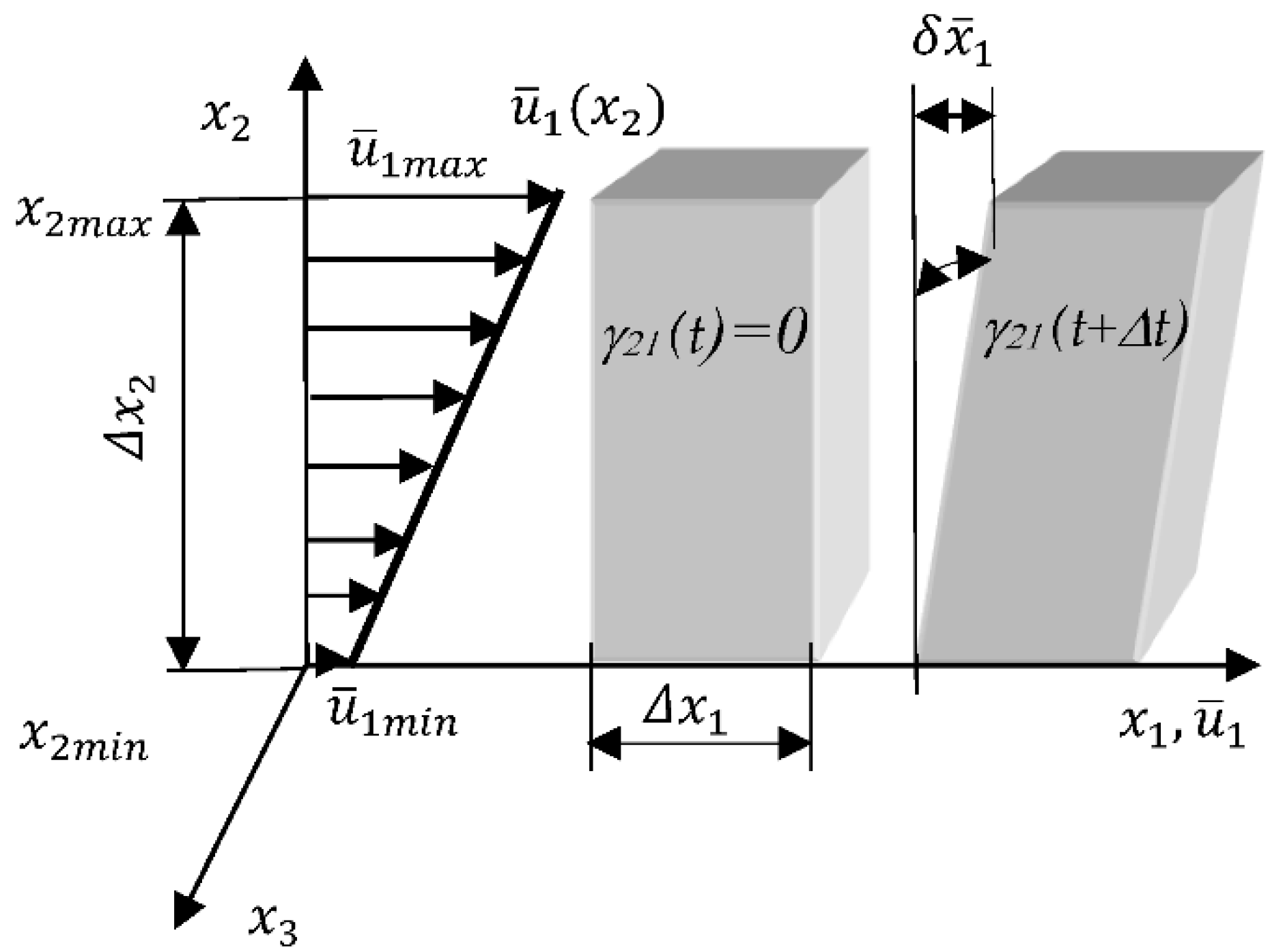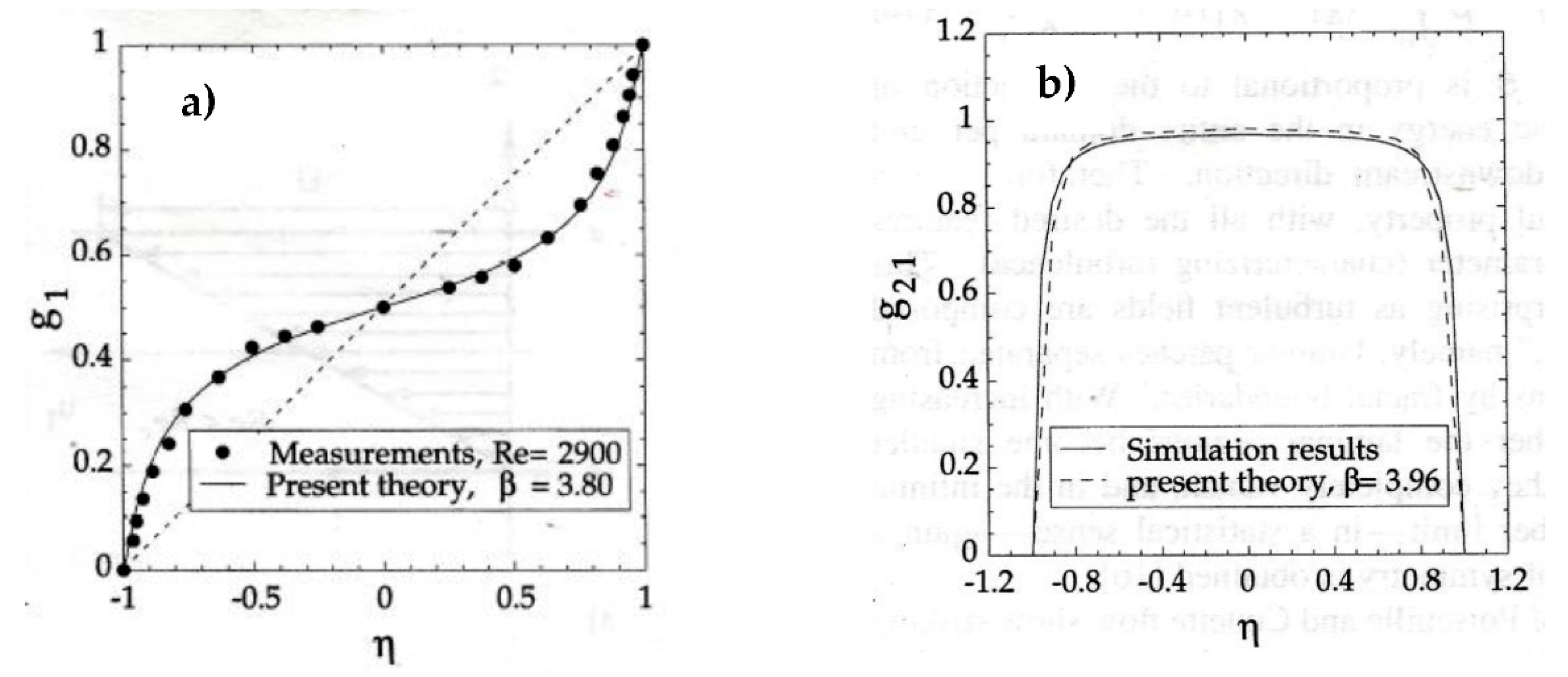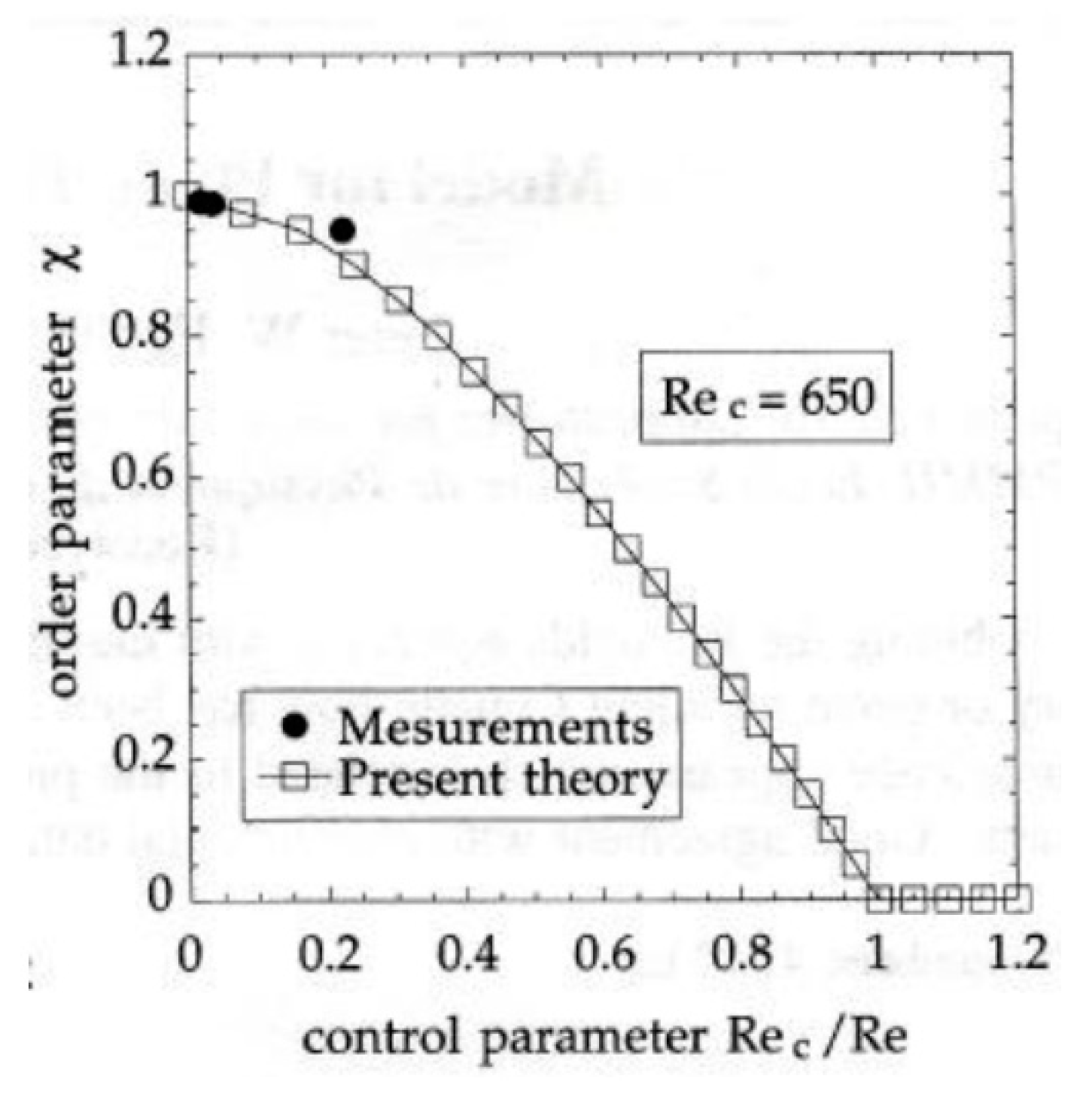A Constitutive Equation of Turbulence
Abstract
:1. Introduction
2. The General Form of Constitutive Equations
3. Constitutive Equation of Laminar Flows
3.1. Newton’s Law of Viscosity
3.2. Some Results of the Kinetic Theory of Gases
4. Constitutive Equations of Turbulent Flows
4.1. The Closure Problem
4.2. Kraichnan’s Direct Interaction Approximation (DIA)
4.3. The Boussinesq Closure Approximation
4.4. Prandtl’s Mixing-Length Turbulence Model
4.5. The Difference-Quotient Turbulence Model
4.6. A ‘Microscopic Theory’ of Turbulence
4.7. Analytical Solutions of Elementary Turbulent Flow Problems
4.7.1. Introduction
4.7.2. Turbulent Wake Flow
4.7.3. The Turbulent Axisymmetric Jet
4.7.4. Plane Turbulent Couette Flow
4.8. Turbulence: A Critical Phenomenon
4.9. The Analogy between Laminar and Turbulent Flows
5. Conclusions
Author Contributions
Funding
Acknowledgments
Conflicts of Interest
References
- Egolf, P.W. A new model on turbulent shear flows. Helv. Phys. Acta 1991, 64, 944–945. [Google Scholar]
- Schlichting, H. Boundary-Layer Theory; McGraw-Hill Inc.: New York, NY, USA, 1979. [Google Scholar]
- Oldham, K.B.; Spanier, J. The Fractional Calculus; Academic Press: New York, NY, USA, 1974. [Google Scholar]
- Reif, F. Physikalische Statistik und Physik der Wärme; Walter de Gruyter: Berlin, Germany, 1975. (In German) [Google Scholar]
- Lévy, P. Calcules des Probabilités; Gauthier Villars: Paris, France, 1925. (In French) [Google Scholar]
- Frisch, U. Turbulence—The Legacy of A.N. Kolmogorov; Cambridge University Press: Cambridge, UK, 1995. [Google Scholar]
- Barenblatt, G.I. Scaling, Self-Similarity, and Intermediate Asymptotics; Cambridge University Press: Cambridge, UK, 2005. [Google Scholar]
- Pomeau, Y.; Manneville, P. Intermittent transition to turbulence in dissipative dynamical systems. Commun. Math. Phys. 1980, 74, 189–197. [Google Scholar] [CrossRef]
- Metzler, R.; Klafter, J. The random walk’s guide to anomalous diffusion: A fractional dynamics approach. Phys. Rep. 2000, 339, 1–77. [Google Scholar] [CrossRef]
- Foias, C.; Manley, O.; Rosa, R.; Temam, R. Navier-Stokes Equations and Turbulence; Cambridge University Press: Cambridge, UK, 2001. [Google Scholar]
- Newton, I. Philosophiae Naturalis Principia Mathematica; Jussu Societatis Regiae ac Typis Josephi Streater: London, UK, 1687. (In Latin) [Google Scholar]
- Hutter, K.; Wang, Y. Vol 2, Advanced Fluid Dynamics and Thermodynamic Fundamentals. In Fluid and Thermodynamics in Geophysical Context; Springer: Berlin, Germany, 2016. [Google Scholar]
- Egolf, P.W.; Hutter, K. Nonlinear, Nonlocal and Fractional Turbulence; Springer International Publishing: Cham, Switzerland, 2019. [Google Scholar]
- Hamba, F. Nonlocal analysis of the Reynolds stress in turbulent flows. Phys. Fluids 2005, 17, 115102-1–115102-9. [Google Scholar] [CrossRef] [Green Version]
- Egolf, P.W.; Hutter, K. Fractional Turbulence Models. In Progress in Turbulence VII; Springer: Cham, Switzerland, 2017; Volume 196, pp. 123–131. [Google Scholar]
- Romanof, N. Non-local models in turbulent diffusion. Z. Meterol. 1989, 39, 89–93. [Google Scholar]
- Kraichnan, R.H. Direct-interaction approximation for shear and thermally driven turbulence. Phys. Fluids 1964, 7, 1048–1062. [Google Scholar] [CrossRef]
- Boussinesq, J. Mémoires présentés par divers savants à l’Académie des Sciences. In Essai sur la Théorie des Eaux Courantes; Imprimerie Nationale: Paris, France, 1877; Volume 23, pp. 1–680. (In French) [Google Scholar]
- Vergano, D. Turbulence theory gets a bit choppy. USA Today, 10 September 2006. [Google Scholar]
- Prandtl, L. Bericht über Untersuchungen zur ausgebildeten Turbulenz. ZAMM J. Appl. Math. Mech. 1925, 5, 136–139. [Google Scholar] [CrossRef]
- Egolf, P.W. Lévy statistics and beta model: A new solution of “wall” turbulence with a critical phenomenon. Int. J. Refr. 2009, 32, 1815–1836. [Google Scholar] [CrossRef]
- Samba, F.K.C.; Egolf, P.W.; Hutter, K. Nonlocal Turbulence Modeling Close to Criticality Involving Kolmogorov’s Dissipation Microscales; Springer: Cham, Switzerland, 2017; Volume 226, pp. 163–170. [Google Scholar]
- Mandelbrot, B. The Fractal Geometry of Nature; W.H. Freeman and Company: New York, NY, USA, 1982. [Google Scholar]
- Egolf, P.W. Difference-quotient turbulence model: A generalization of Prandtl’s mixing-length theory. Phys. Rev. E 1994, 49, 1260–1268. [Google Scholar] [CrossRef] [Green Version]
- Egolf, P.W.; Hutter, K. Turbulent Shear Flow Described by the Algebraic Difference-Quotient Turbulence Model; Springer: Heidelberg, Germany, 2016; Volume 165, pp. 105–109. [Google Scholar]
- Hunt, J.C.R.; Phillips, O.M.; Williams, D. Turbulence and Stochastic Processes: Kolmogorov’s Ideas 50 Years On; The Royal Society: London, UK, 1991. [Google Scholar]
- Egolf, P.W. Difference-quotient turbulence model: The axi-symmetric isothermal jet. Phys. Rev. E 1998, 58, 459–470. [Google Scholar] [CrossRef] [Green Version]
- Egolf, P.W.; Weiss, D.A. A model of turbulent plane Couette flow. Phys. Rev. Lett. 1995, 75, 2956–2959. [Google Scholar] [CrossRef] [PubMed] [Green Version]
- Egolf, P.W.; Weiss, D.A. Difference-quotient turbulence model: Analytical solutions for the core region of plane Poiseuille flow. Phys. Rev. E 2000, 62, 553–563. [Google Scholar] [CrossRef] [PubMed] [Green Version]
- Hinze, J.O. Turbulence; McGraw-Hill Book Company: New York, NY, USA, 1975. [Google Scholar]
- Wygnanski, I.; Fiedler, H.J. Some measurements in the self-preserving jet. J. Fluid Mech. 1969, 38, 577–612. [Google Scholar] [CrossRef] [Green Version]
- Reichardt, H. Gesetzmässigkeiten der Geradlinigen Turbulenten Couette-Strömung; Mitteilungen aus dem Max-Planck-Institut für Strömungsforschung und der Aerodynamischen Versuchsanstalt (Selbstverlag): Göttingen, Germany, 1959. (In German) [Google Scholar]
- Lee, M.J.; Kim, J. The structure of turbulence in a simulated plane Couette flow. In Proceedings of the Eighth Symposium on Turbulent Shear Flows, Munich, Germany, 9–11 September 1991; Volume 1. [Google Scholar]
- Goldenfeld, N. Lectures on Phase Transitions and the Renormalization Group; Addison-Wesley Publishing Company: Boston, MA, USA, 1992. [Google Scholar]
- Ma, S.-K. Modern Theory of Critical Phenomena; The Benjamin/Cummings Publishing Company, Inc.: Reading, MA, USA, 1982. [Google Scholar]
- Bramwell, S.T.; Holdsworth, P.C.W.; Pinton, J.-F. Universality of rare fluctuations in turbulence and critical Phenomena. Nature 1998, 396, 552–554. [Google Scholar] [CrossRef]
- Castaign, B.J. Conséquences d’un principe d’extremum en turbulence. J. Phys. France 1989, 50, 147–156. (In French) [Google Scholar]
- Egolf, P.W.; Hutter, K. The mean field theory of magnetism and turbulence. J. Entropy 2017, 19, 589. [Google Scholar] [CrossRef] [Green Version]






| Laminar Flow | Turbulent Flow | Laminar Flow | Turbulent Flow | ||
|---|---|---|---|---|---|
| Model | Newton’s law of viscosity | Difference-Quotient Turbulence Model (DQTM) | Dimensionless velocity | ||
| Char. length | λ | Differential equation | (Linear) | (Nonlinear) | |
| Char. velocity | Boundary conditions | ||||
| Shear stress | Mean stream-wise velocity | (Linear) | (Nonlinear) | ||
| (Effective) dynamic viscosity | Stress para- meter Re | ||||
| Dimensionless variable | Order para- meter χ |
Publisher’s Note: MDPI stays neutral with regard to jurisdictional claims in published maps and institutional affiliations. |
© 2021 by the authors. Licensee MDPI, Basel, Switzerland. This article is an open access article distributed under the terms and conditions of the Creative Commons Attribution (CC BY) license (https://creativecommons.org/licenses/by/4.0/).
Share and Cite
Egolf, P.W.; Hutter, K. A Constitutive Equation of Turbulence. Fluids 2021, 6, 414. https://doi.org/10.3390/fluids6110414
Egolf PW, Hutter K. A Constitutive Equation of Turbulence. Fluids. 2021; 6(11):414. https://doi.org/10.3390/fluids6110414
Chicago/Turabian StyleEgolf, Peter W., and Kolumban Hutter. 2021. "A Constitutive Equation of Turbulence" Fluids 6, no. 11: 414. https://doi.org/10.3390/fluids6110414
APA StyleEgolf, P. W., & Hutter, K. (2021). A Constitutive Equation of Turbulence. Fluids, 6(11), 414. https://doi.org/10.3390/fluids6110414






